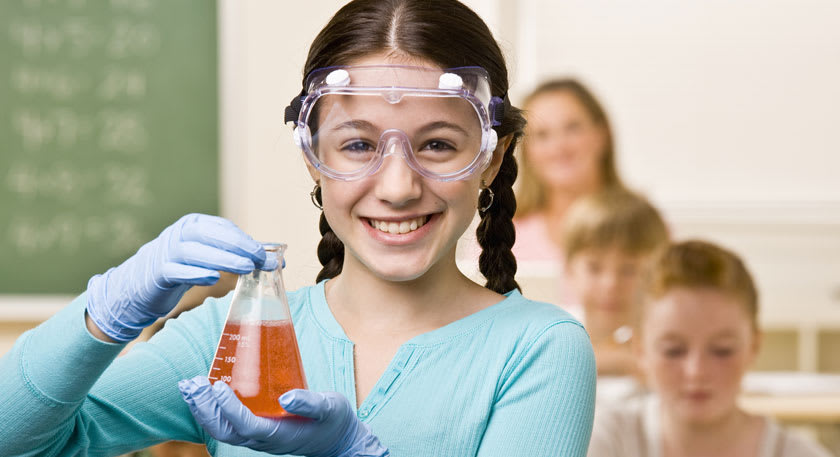11 Things You May Not Know About Eye Protection

Elementary/Middle School/High School
Keeping students safe is one of the top priorities of every school community, and the science classroom is no exception. Dangers abound, especially for the eyes, and protection is essential. Two things you probably already knew about eye protection in schools are: 1) Students, teachers, and visitors are required to wear industrial-quality eye protection when participating in any laboratory activities that use chemicals, heat, or glassware, and 2) prescription eyeglasses don’t count.
Now here are 11 things you may not know:
1. Whenever chemicals are being used, indirect-vent safety goggles (a.k.a. chemical-splash goggles) should be worn. They fit the face surrounding the eyes snugly to protect from a variety of hazards and have specially designed vents that don’t allow liquids to get inside.
2. When glassware, or heating sources are being used, indirect-vent or direct-vent safety goggles should be worn.
3. For many earth science laboratory or field activities not involving corrosive materials, safety glasses with side shields are suitable.
4. Dirty eye protection is unsafe eye protection, not only because vision can be obscured while working, but because obscured vision may make students want to remove their eye protection completely. Clean lenses between uses by rinsing them with water and wiping with a soft cloth or lens cleaning towelettes.
[StartProductBlock]
Lens Cleaning Towelettes
These towelettes work for all industrial, safety, and personal eyewear lenses.
[EndProductBlock]
5. Similarly, goggles that are tight to the face may fog easily and obscure vision. CrossVent™ Technology and anti-fog coatings can help stop them from fogging up.
6. The American National Standards Institute (ANSI) is a private, non-profit organization that creates quality and safety standards for a wide variety of products, including safety eyewear. When we say a product is “ANSI approved,” it means it has been tested by ANSI and deemed safe for use.
7. ANSI has two types of impact tests, a basic impact test in which a steel projectile is dropped onto the lens of safety eyewear, and a high-impact test in which a steel projectile is shot into the lens. Eyewear that is ANSI Z87 rated has passed the basic impact test, as well as other durability and chemical exposure tests. Eyewear that is ANSI Z87+ rated has also passed the high-impact test.
8. ANSI also tests for splash, droplet, and dust protection. Eyewear rated D3 protects from splashes and droplets only. Eyewear rated D4 also protects from dust, and eyewear rated D5 protects from fine dust.
9. If you’re wondering whether it’s safe for students to wear contact lenses, particularly during activities using chemicals, recent studies and experiments have suggested that contact lenses do not increase risks when worn with other eye protection and may actually minimize or prevent injury in some situations.
10. Face shields are not a substitute for chemical splash safety goggles. When maximum protection from flying particles and harmful liquids is needed, face shields should be worn with goggles. Another option during a chemical demonstration is to use a benchtop safety shield to protect the students.
[StartProductBlock]
SCIENCEWARE® Large Weighted Safety Shield
Exceptional impact resistance and optical clarity.
[EndProductBlock]
11. If goggles or safety glasses are shared among students, they should be sterilized between uses to prevent the spread of disease. Diluted bleach or Lysol® can be used to sterilized eyewear. A storage cabinet with UV sterilization is another time-saving option.
[StartProductBlock]
Goggle Sanitizing Cabinet
This cabinet quickly and safely sanitizes goggles for the entire classroom.
[EndProductBlock]
If you’re ready to put what you’ve learned to use in finding safety eyewear for your students, head over to our eye protection page. Once you’ve selected goggles or safety glasses in the top left corner of the page, our selector tool will help you find eyewear with additional features like UV protection and scratch resistance.
Have questions about eye protection or just want more ways the help students discover their world? Ask the Ward’s Science Plus Us team at sciencehelp@vwr.com. Our in-house scientists and technicians are ready to answer even the toughest inquiries.
Related content:
